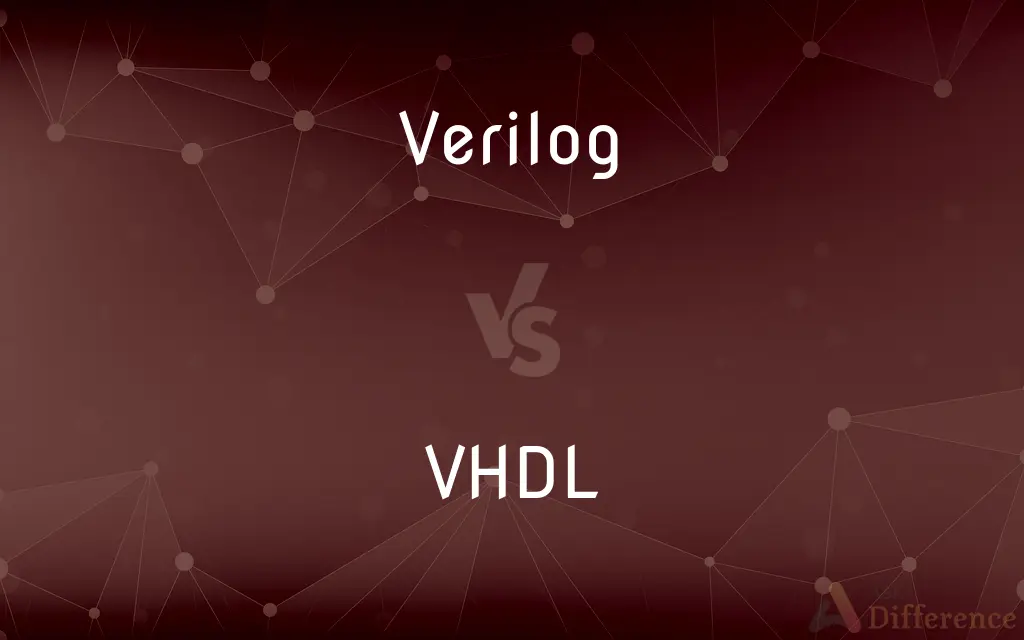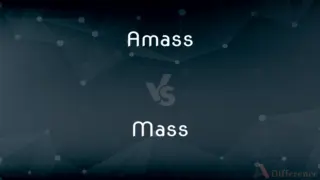Verilog vs. VHDL — What's the Difference?
Edited by Tayyaba Rehman — By Fiza Rafique — Published on December 13, 2023
Verilog and VHDL are both hardware description languages used in electronic design automation. While Verilog is syntax-wise similar to C, VHDL is akin to Ada.

Difference Between Verilog and VHDL
Table of Contents
ADVERTISEMENT
Key Differences
Verilog and VHDL are instrumental in the field of electronic design automation (EDA). Both serve as hardware description languages (HDLs), allowing designers to describe the behavior and structure of digital circuits. However, while Verilog exhibits a syntax reminiscent of the C programming language, VHDL's syntax mirrors that of the Ada programming language.
Both Verilog and VHDL enable the modeling of digital circuits at various abstraction levels, from the gate level to the behavioral level. Nevertheless, VHDL tends to be more verbose in its descriptions compared to Verilog. This verbosity can provide more explicitness in VHDL designs, which some designers find advantageous, while others prefer the more concise nature of Verilog.
It's also worth noting that Verilog and VHDL originated from different parts of the world. Verilog was developed primarily in the United States by Gateway Design Automation in the 1980s. On the flip side, VHDL was developed in the 1980s for the U.S. Department of Defense by the Intermetrics company, making it more prevalent in European projects for some time.
Regarding simulation and synthesis, both Verilog and VHDL are supported by a vast array of EDA tools. These tools facilitate the simulation, synthesis, and testing of digital designs described using either language. Yet, there might be slight variations in how certain constructs are synthesized in Verilog compared to VHDL, leading to different hardware implementations.
Lastly, both languages have evolved over time, and newer versions have been released. For instance, SystemVerilog is an extension of Verilog, adding enhanced features, while VHDL has seen updates in its standards, with VHDL-2008 being one of the latest revisions. Both languages, with their strengths and nuances, continue to play pivotal roles in digital design.
ADVERTISEMENT
Comparison Chart
Syntax similarity
Similar to C
Similar to Ada
Verbose
Less verbose
More verbose
Origin
Developed by Gateway Design Automation
Developed for the U.S. Department of Defense
Predominant use
U.S.-centric initially
European projects initially
Extensions/Revisions
SystemVerilog is an extension
VHDL-2008 is a recent revision
Compare with Definitions
Verilog
Verilog can describe digital circuits at multiple abstraction levels.
From simple gates to intricate systems, Verilog offers a wide modeling spectrum.
VHDL
VHDL is comprehensive and can describe digital systems verbosely.
Detailed specifications often translate to VHDL due to its explicit nature.
Verilog
It resembles the C programming language in syntax.
Programmers familiar with C might find transitioning to Verilog smoother.
VHDL
VHDL stands for VHSIC Hardware Description Language.
VHDL is a popular choice among European digital circuit designers.
Verilog
Verilog is a hardware description language.
Designers often use Verilog to model complex digital circuits.
VHDL
VHDL has seen multiple revisions over the years.
VHDL-2008 introduced several enhancements, streamlining digital design further.
Verilog
It's widely used in electronic design automation.
Many modern FPGAs and ASICs are designed using Verilog.
VHDL
It has a syntax resembling the Ada programming language.
Ada programmers might find VHDL's structure and syntax familiar.
Verilog
SystemVerilog extends the capabilities of Verilog.
For advanced features and more robust testing, designers often lean towards SystemVerilog.
VHDL
It's an integral part of the electronic design automation toolkit.
VHDL plays a crucial role in the design and verification of many digital systems.
Common Curiosities
Where was Verilog developed?
Verilog was developed in the U.S. by Gateway Design Automation.
Which language is more verbose?
VHDL tends to be more verbose compared to Verilog.
What are Verilog and VHDL primarily used for?
Both Verilog and VHDL are hardware description languages used in electronic design automation.
What's an extension of Verilog?
SystemVerilog is an extension of Verilog, offering enhanced features.
Has VHDL seen any revisions?
Yes, VHDL has had several revisions, with VHDL-2008 being one of the recent ones.
How is Verilog's syntax compared to VHDL's?
Verilog has a syntax similar to C, while VHDL's syntax is akin to Ada.
Which language was more prevalent in European projects?
VHDL was more predominant in European projects initially.
Are both languages supported by modern EDA tools?
Yes, both Verilog and VHDL are widely supported by contemporary EDA tools.
How does Verilog differ from SystemVerilog?
SystemVerilog extends Verilog, adding advanced features and functionalities.
Can both languages describe digital systems at various abstraction levels?
Yes, both Verilog and VHDL can describe digital systems from gate level to behavioral level.
Do Verilog and VHDL always synthesize to the same hardware?
No, certain constructs might synthesize differently in Verilog compared to VHDL.
Is VHDL's verbosity an advantage or disadvantage?
The verbosity can be an advantage for explicitness in designs, but some designers might prefer the conciseness of Verilog.
Which language was developed for the U.S. Department of Defense?
VHDL was developed for the U.S. Department of Defense.
Are there any major electronic components designed using these languages?
Yes, many modern FPGAs, ASICs, and other digital systems are designed using either Verilog or VHDL.
Which language is considered less verbose?
Verilog is generally considered less verbose than VHDL.
Share Your Discovery

Previous Comparison
Futures vs. Options
Next Comparison
Amass vs. MassAuthor Spotlight
Written by
Fiza RafiqueFiza Rafique is a skilled content writer at AskDifference.com, where she meticulously refines and enhances written pieces. Drawing from her vast editorial expertise, Fiza ensures clarity, accuracy, and precision in every article. Passionate about language, she continually seeks to elevate the quality of content for readers worldwide.
Edited by
Tayyaba RehmanTayyaba Rehman is a distinguished writer, currently serving as a primary contributor to askdifference.com. As a researcher in semantics and etymology, Tayyaba's passion for the complexity of languages and their distinctions has found a perfect home on the platform. Tayyaba delves into the intricacies of language, distinguishing between commonly confused words and phrases, thereby providing clarity for readers worldwide.












































